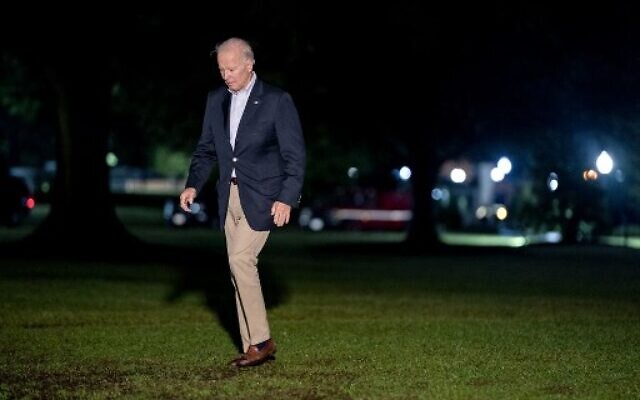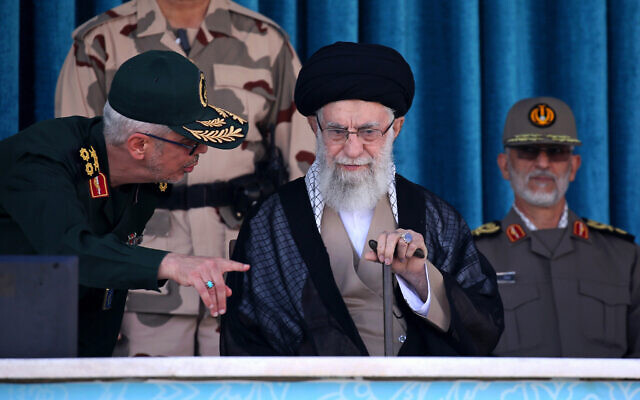Iranian President Ebrahim Raisi on Tuesday appealed for national unity and tried to allay anger against the country’s rulers, even as the anti-government protests that have engulfed the country for weeks continued to spread to universities and high schools.
Raisi acknowledged that the Islamic Republic had “weaknesses and shortcomings,” but repeated the official line that the unrest sparked last month by the death of a 22-year-old woman in the custody of the country’s morality police was nothing short of a plot by Iran’s enemies.
“Today the country’s determination is aimed at cooperation to reduce people’s problems,” he told a parliament session. “Unity and national integrity are necessities that render our enemy hopeless.”
His claims echoed those of Iran’s Supreme Leader Ayatollah Ali Khamenei, who blamed the United States and Israel, the country’s adversaries, for inciting the unrest in his first remarks on the nationwide protests on Monday. It’s a familiar tactic for Iran’s leaders, who have remained mistrustful of Western influence since the 1979 Islamic Revolution and commonly blame domestic problems on foreign enemies without offering evidence.
The protests, which emerged in response to the death of 22-year-old Mahsa Amini after her arrest for allegedly violating the Islamic Republic’s strict dress code, have embroiled dozens of cities across the country and evolved into the most widespread challenge to Iran’s leadership in years. A series of mounting crises have festered and helped fuel public rage, including the country’s political repression, ailing economy, and global isolation.
Get The Times of Israel's Daily Edition by email and never miss our top stories
Iran’s security forces have sought to disperse demonstrations with tear gas, metal pellets, and in some cases live fire, rights groups say. Iran’s state TV reports that violent confrontations between protesters and the police have killed at least 41 people, but the Oslo-based group Iran Human Rights has put the death toll at 92.
For anyone who thought the #IranProtests will be over in days, this is today, week 3, from Ferdowsi university, city of Mashahd, NE Iran. Women in middle, headscarf off, men cheering them from back as they chant for change: pic.twitter.com/VhnFsdB0ua
— Joyce Karam (@Joyce_Karam) October 1, 2022
Amnesty International said earlier it had confirmed 53 deaths, after Iran’s semi-official Fars news agency said last week that “around 60” people had died.
At least 12 members of the security forces have been reported killed since September 16.
As the new academic year officially began this week, the demonstrations spread quickly to university campuses, long considered sanctuaries in times of turmoil.
Videos on social media showed students expressing solidarity with peers who had been arrested and calling for the end of the Islamic Republic. Roiled by the unrest, many universities moved classes online this week.
The prestigious Sharif University of Technology in Tehran became a battlefield on Sunday as security forces surrounded the campus from all sides and fired tear gas at protesters who were holed up inside a parking lot, preventing them from leaving. The student union reported that police arrested hundreds of students, although many were later released.
In one video on Monday, students marched and chanted, “Jailed students must be freed!” at Tarbiat Modares University in Tehran. In another, students streamed through Khayyam University in the conservative city of Mashhad, shouting, “Sharif University has become a jail! Evin Prison has become a university!” — referring to Iran’s notorious prison in Tehran.
Protests also appeared to grip gender-segregated high schools across Iran on Monday, where groups of young girls waved their state-mandated hijabs and chanted “Woman! Life! Freedom!” in the city of Karaj west of the capital and in the Kurdish city of Sanandaj, according to widely shared footage.
The response by Iran’s security forces has sparked widespread global condemnation. On Monday, US President Joe Biden said his administration was “gravely concerned about reports of the intensifying violent crackdown on peaceful protesters in Iran, including students and women.”
“This week, the United States will be imposing further costs on perpetrators of violence against peaceful protesters,” Biden said in a statement. “We will continue holding Iranian officials accountable and supporting the rights of Iranians to protest freely.”
The US president gave no indication of what measures he was considering against Iran, which is already under crippling US economic sanctions largely related to its controversial nuclear program.

US President Joe Biden walks on the South Lawn of the White House in Washington, DC, on October 3, 2022. (Stefani Reynolds/AFP)
Furious over Iran’s response to the demonstrations, the British foreign office summoned the Iranian ambassador in London.
“The violence leveled at protests in Iran by the security forces is truly shocking,” said British Foreign Secretary James Cleverly.
Nuclear talks
Iran accused the US leader of “hypocrisy” in invoking human rights to impose fresh punitive measures.
“It would have been better for Mr. Joe Biden to think a little about the human rights record of his own country before making humanitarian gestures, although hypocrisy does not need to be thought through,” Foreign Ministry spokesman Nasser Kanani said in an Instagram post, reported by Iranian media.
“The US president should be concerned about the numerous sanctions… against the Iranian nation, the sanctions whose imposition against any nation is a clear example of a crime against humanity,” he added.

In this picture released by the official website of the office of the Iranian supreme leader, Supreme Leader Ayatollah Ali Khamenei, center, listens to chief of the General Staff of the Armed Forces Gen. Mohammad Hossein Bagheri at a graduation ceremony for a group of armed forces cadets at the police academy in Tehran, Iran, October 3, 2022. (Office of the Iranian Supreme Leader via AP)
Iran’s Supreme Leader Ayatollah Ali Khamenei had Monday accused arch-foes, the United States and Israel, of fomenting the protests.
The riots “were engineered by America and the occupying, false Zionist regime, as well as their paid agents, with the help of some traitorous Iranians abroad,” Khamenei said.
The unrest has overshadowed diplomatic efforts to revive a 2015 nuclear deal between Iran and major powers which had come close to a breakthrough in recent months before stalling again.
But White House Press Secretary Karine Jean-Pierre stressed that the “problems with Iran’s behavior” are separate from efforts to revive the nuclear deal, which Washington will pursue “as long as we believe” it is in US national security interests.


